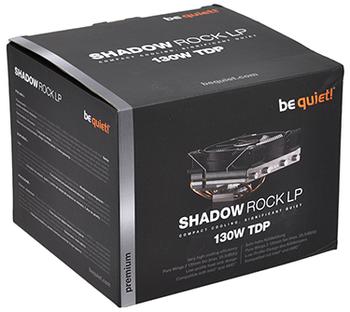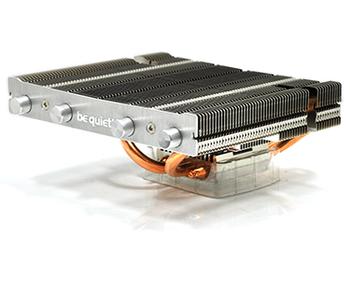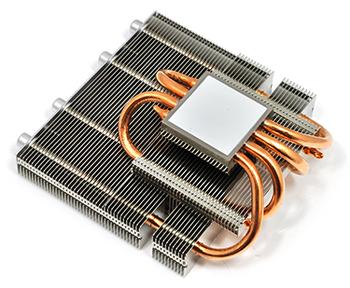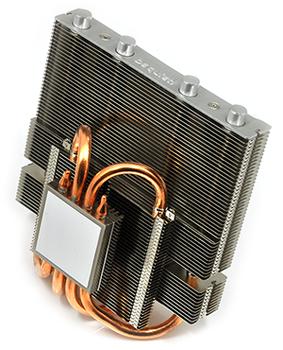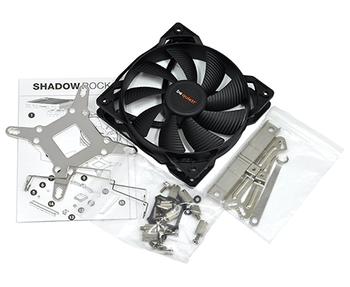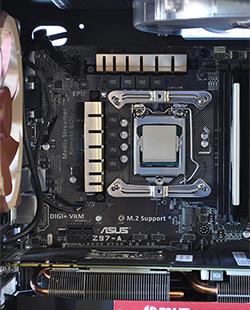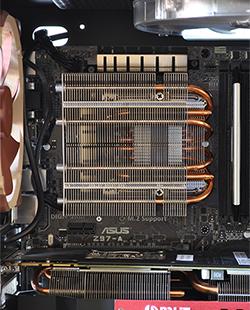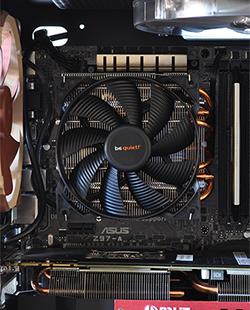Introduction
be quiet! has expanded its range of premium CPU cooling solutions with the launch of the Shadow Rock LP. Premium in design and presentation but not necessarily in price, the new addition to the Shadow Rock range fetches £30 at retail.
According to the manufacturer: "If you are seeking the best possible mix of premium cooling performance for restricted space situations, remarkably quiet operations, eye-catching design, and a highly attractive price in the compact CPU cooler segment, seek no further." That's be quiet!'s official stance, so let's open it up and see if those claims hold true.
Aimed specifically at HTPC (Home Theatre PC) or SFF (Small Form Factor) systems, the Shadow Rock LP - which, in case you hadn't guessed, stands for Low Profile - features a shallow aluminium heatsink measuring 134mm x 122mm x 50mm in size.
Build quality is good throughout, with four 6mm-thick copper heatpipes navigating between the fin stacks and a smooth CNC-machined copper contact plate. Thermal paste is pre-applied to help simplify the initial installation, and we like the fact that be quiet! has added aluminium caps to the ends of the heatpipes to tidy up appearance.
Nickel-coated heatpipes might have further streamlined the overall aesthetic, but would have done so at the expense of cooling performance, and though the Shadow Rock LP isn't as stylish as some of be quiet!'s larger coolers, it's still a neat-looking unit.
Mounting brackets for the latest Intel and AMD sockets are all included, as is a single Pure Wings 2 fan, but it's unfortunate be quiet! doesn't provide any additional thermal paste as part of the bundle. The cooler's good for a single install, but you'll need to source your own thermal compound for any re-installs further down the line.
The 120mm PWM Pure Wings 2 fan isn't a top-of-the-range model - it sits below the Silent Wings and Shadow Wings in terms of pecking order - however it's still a good quality unit and a cut above many generic solutions. Measuring 25mm-thick, the fan increases the cooler's overall height to 75mm and is outfitted with nine "silence-optimised" fan blades capable of operating at speeds of up to 1,500rpm.
Put the fan and heatsink together and be quiet! reckons there's enough cooling capacity to support CPUs with a TDP of up to 130W. Plenty of headroom for anything you're likely to put inside a HTPC, we feel, and enough scope for a touch of overclocking should you feel the need.
We're liking what we've seen so far, but we've sliced enough fingers on previous be quiet! coolers to know that simple installation hasn't exactly been the German manufacturer's forte. So is the Shadow Rock LP any easier to work with? Well, yes, but that doesn't mean to say installation is a doddle.
On an Intel LGA 1150 socket, you begin by fixing the backplate to the mounting brackets using four O-rings, four screws and four nuts. The assembly feels secure once in situ, and can then be used to attach the heatsink - this process involves passing a mounting bridge over the contact plate and using two fastening screws to fix the heatsink to the mounting brackets. Gaps have been left in the fin stack to make it easy to reach the screws, but it's a shame the screws aren't part of the mounting bridge - they had a tendency to fall out, making the whole process a bit of a juggling act.
Installation ultimately isn't as straightforward as, say, a Noctua, but while the process is a little more involved there are no major criticisms and the Shadow Rock LP shouldn't take long to implement. It's always going to be a tight squeeze in a small-form-factor environment so remember to check the dimensions carefully, but we've had no clearance issues on our ATX Asus Z97-A board. The offset fin stack ensures plenty of room to one side, and if you're using memory void of tall heatspreaders, the cooler can encompass the DIMM slots, allowing the top-down fan to cool surrounding components.
Nifty little cooler, it seems. Now let's find out what level of performance you can you expect from a low-profile design, and whether or not the Shadow Rock LP is as quiet as it's made out to be.



